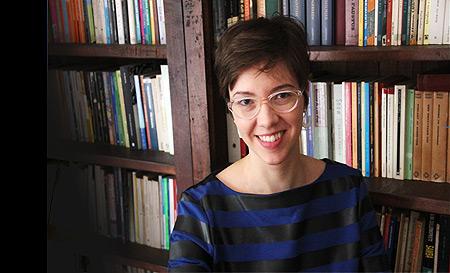Laura Erber has just returned to Rio de Janeiro in order to complete her PhD-dissertation based on research conducted in Copenhagen. We asked her about the project and about her stay in Denmark.
What is your research project about?
In my PhD-dissertation I attempt to analyze Dreyer's films based on the contrast between what happens with the bodies and faces of Dreyer's characters, and what they express through speech and text.
You find characters in these films who seem to have received a surfeit of prophetic and powerful speech gifts, like Johannes in The Word. When he voices his prophecies about amazing and wondrous things, his face remains neutral and his walk and movement like that of an automaton.
On the other hand, in Joan of Arc, Joan endures a verbal interrogation that forces her to speak, even after she has nothing left to say nor the energy to endure the court's crafty rhetoric. While her speech becomes more and more quiet and her replies fewer and fewer, her face and bodily expression appears to grow stronger.
However, I think the most important and interesting thing about Dreyer is that while the rest of his contemporary filmmakers where striving for a synchronicity and a unity between words and images, he questioned the esthetic that unites and confuses the body with the voice and the words with the subject.
It's my sense that Dreyer, even if he never expressed it clearly in interviews or notes, was conscious that there would always be an interval and lack of symmetry between what the body does and what the words express; between subject and the linguistic expression. It is akin to what French psychoanalyst Jacques Lacan refers to when he defines the voice as an object, apart from the body. In other words, the speaking body is always a collage and never an unbreakable unit.
Where does the motivation to research Dreyer come from?
Dreyer is known and admired in Brazil. In a critical essay by Glauber Rochas he compares the Brazilian director Joaquim Pedro de Andrade's O Padre e a Moça (The Priest and the Girl) from 1966 with Dreyer. Dreyer's films made a big impression on the Cinema Novo generation's directors, and even though you can't really say he's well known by a larger audience, his work generates commentary and is often cited. Unfortunately in Brazil we normally only have access to Dreyer's most famous films, and most people are not familiar with any of his other silent movies besides Joan of Arc. And because of that the interested viewers do not have a clear idea of his cinematic development.
How was your experience working with the Dreyer archive?
The Dreyer website is fantastic, very complete and really well thought out. I'd say that for a researcher it's paradise because it offers many different and varied approaches to Dreyer and his work. There are different levels of information and they are all mutually linked in some way. But it's obvious that the meeting with the raw archival material always is a surprise, especially because Dreyer himself was such a passionate researcher who created his own archival system and methods of cataloguing all the material he collected on his various projects.
From my point of view the website has served another function in that it offers entry into an enormous amount of material in a very intelligent manner while it doesn't attempt to make the actual archive superfluous. Here, however, the researcher can experience a more intense and direct contact with Dreyer's way of thinking, and in meeting his passions and obsessions gain a more direct and intimate contact with his creativity. I think the website and the physical archive supplement each other very well.
What is it like for a foreign researcher to utilize the Dreyer Archive?
I have felt very welcome and more than comfortable. The reception I got was exceptional and I was afforded the freedom that turns the meeting with the material into an intimate and intense experience. I will miss this research environment. I also worked at the Royal Danish Library with the goal of reading through the critical bibliography. That was also a great experience in that the search and reservation system works extremely well.
By FILMUPDATE │ 16 June 2011
